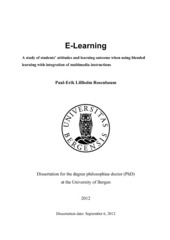E-Learning. A study of students’ attitudes and learning outcome when using blended learning with integration of multimedia instructions
Doctoral thesis
Permanent lenke
https://hdl.handle.net/1956/6197Utgivelsesdato
2012-09-06Metadata
Vis full innførselSamlinger
Sammendrag
The advent of new technologies has provided opportunities and challenges for education institutions to seek more effective ways of teaching and learning. Elearning is now an established phenomenon in education and institutions are increasing their effort to offer greater flexibility, more personalized learning, and greater learner satisfaction. Consequently blended learning has emerged as a delivery method that addresses the face-to-face advantages of a traditional classroom and the time efficiency and location convenience of an online teaching and learning environment. The opportunities of flexibility and convenience are not evident in a classroom environment. However the face-to-face interactions provide the foundation for social communication which can be critical to online learning. Educators who are comfortable with traditional classroom delivery will meet learners’ enhanced demands for flexibility through online presence for courses. As educators are generally time-pore, and with little clear direction, research can give them valuable insights into advantaged and disadvantaged of various teaching and learning formats. This thesis examines students’ attitudes when using blended learning with integration of multimedia instructions. It identifies aspects around cognitive learning outcome and provides insight into students’ experiences and their overall satisfaction with this instructional design. The main objective with this initiative is to sustain the evolution from traditional teaching to active learning and to better integrate the increasing number of educational resources online. In particular this study includes aspects about students’ attitudes towards using a blended learning format, learning theories, the instructional principles of multimedia production, and identification of optimal ways to use e-learning. This thesis contributes to the field of e-learning by three main contributions (A1-A3): A1: A contribution utilizing blended learning with integration of multimedia instructions. The quality of the blended learning format is discussed on the basis of the attitudes and experiences from the adult participants. The contribution outlines characteristics about good properties of multimedia instructions to supplement traditional classroom teaching. The content of A1 constitutes a paper that is submitted for journal publication. A2: A model for testing the cognitive learning outcome using a blended learning format with two different teaching treatments. A2 constituted the main part of a conference proceedings paper. The study further contributes in a book with the title: Cases on managing e-learning: Development and implementation. Will be released in 2012. A3: This contribution outlines a blended learning course design for postgraduate dental students with emphasis on flexibility and location convenience. The course was redesigned from a former traditional course format. The content of A3 constitutes a paper that is submitted for journal publication. The research makes a contribution in the exploration of the advantages and disadvantaged of utilizing blended learning. The research methods comprise both quantitative and qualitative investigation approaches. The empirical data for this thesis were collected through 149 participating students and 13 semi-structured interviews. The thesis supports the view of increased favorable ways of teaching and learning when using new online technologies. However no evidence for increased cognitive learning outcome was identified. Nonetheless the blended learning format with integration of multimedia instructions holds an experienced potential for improved quality of teaching and learning in terms of enhanced satisfaction among learners. The main findings. The thesis contributes to the field of e-learning by the following main contributions. First, an identification of educational key issues favourable to a blended learning format with integration of multimedia instructions; second, identification of factors to produce high quality multimedia instructions; third, the design of a test procedure to conduct measurements on cognitive learning outcome based on a basic retention level and a more advanced transfer level; forth, suggestions how to improve the influence of the internet media for future postgraduate dental educational programs.
Består av
Paper I: Rosenbaum, Paul-Erik Lillholm, Mikalsen, Øyvind. (2012) Educational design: Learners’ attitudes towards a blended learning context including online multimedia instructions. Full text not available in BORA due to publisher restrictions.Paper II: Rosenbaum, Paul-Erik Lillholm, Mikalsen, Øyvind, Grahl-Nielsen, Otto. (2012) The learning effect of using a blended learning design in K12 science teaching. Full text not available in BORA due to publisher restrictions.
Paper III: Rosenbaum, Paul-Erik Lillholm, Mikalsen, Øyvind, Lygre, Henning, Solheim, Einar, Schjøtt, Jan. (2012) A blended learning course design in clinical pharmacology for postgraduate dental students. Full text not available in BORA due to publisher restrictions.
